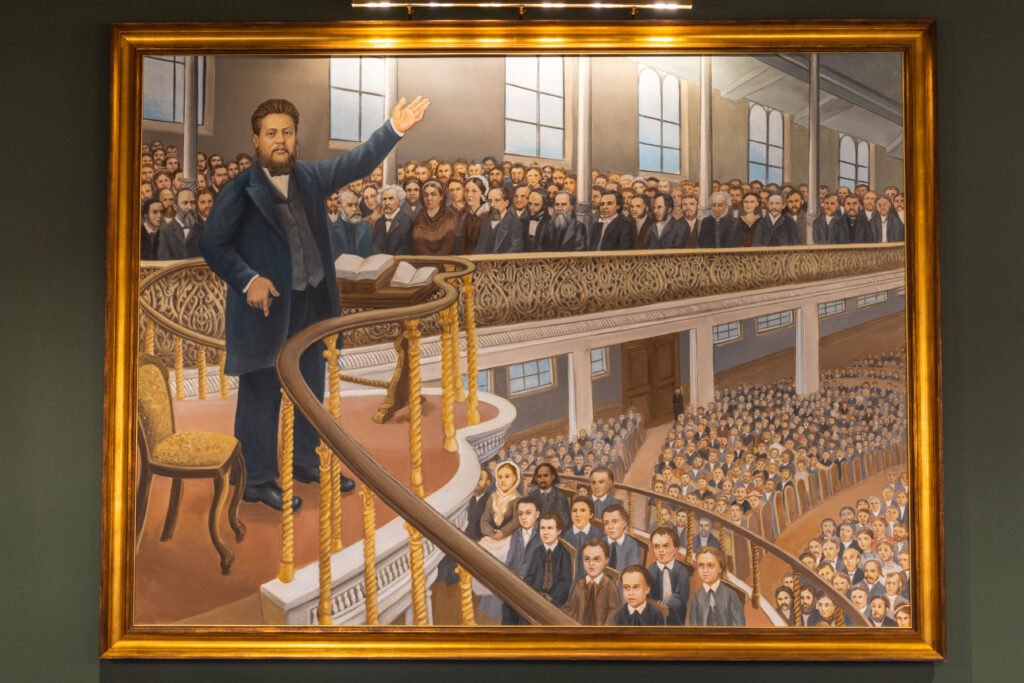
Spurgeon lived during a time when basically to be English was to be a Christian. In 1851, around the time when he began preaching, a religious census was taken throughout the United Kingdom and about 61% of the population reported to be church going. And yet, as Spurgeon observed all the religious activity around him, he saw most of it as merely nominal. Many called themselves Christians but were spiritually dead. To make things worse, churches of his day sought to attract church goers by importing entertainments and ideas from the world, rather than looking to Scripture.
As a pastor, Spurgeon believed that his most important duty was to faithfully preach the Word to his people. He preached at least four times a week: twice on Sundays and twice during the week. Through these Word-centered, theologically rich, gospel-saturated sermons, Spurgeon drew and held together the largest congregation in evangelicalism throughout his ministry. Many were converted under his preaching. To accommodate all those who were coming to hear, in 1861, he would lead his congregation would build a magnificent new building debt-free, the Metropolitan Tabernacle, which seated 6,000. Visitors came from all over the world to hear Spurgeon preach. In this painting, seated in the upper gallery, the artist has depicted a few of the more famous visitors, including D. L. Moody, Samuel Clemens (i.e., Mark Twain), Queen Victoria (dressed in a commoner’s garb), Florence Nightingale, Senator James Garfield from America, and Hudson Taylor.
But Spurgeon did not occupy a preaching a station. He was the pastor of a church. Beyond those visiting, Spurgeon believed that the church was made up of those who had covenanted together as a particular body, marked out by baptism and the Lord’s Supper. As a Baptist, he held to regenerate church membership, which meant that those wishing to be baptized and join the church must have a credible profession of faith. To promote this, he implemented a rigorous, six-step membership process which involved multiple pastoral interviews, a testimony before the congregation, a congregational vote, and more. The Church Meeting Minutes of the Metropolitan Tabernacle reveal that nearly 14,000 people joined the church during Spurgeon’s ministry, and all of them went through the same membership process.
He also held to meaningful church membership, which meant that churches should hold members accountable to their profession of faith. As the pastor of the church, Spurgeon knew he and his few deacons could not provide that kind of spiritual care and accountability for so many people. So, in 1859, after patient teaching, Spurgeon led his congregation to implement the office of elders. These men would devote themselves to the spiritual care of the church, while the deacons would provide for the practical needs of the church. Through their labors together, Spurgeon and his elders and deacons were able to not only take people into membership, but provide discipleship, training, and accountability for every one of them.
The church that started as a few dozen when he first arrived would have a membership of over 5,300 by the time of his death. But this wasn’t a nominal 5,300. These were members who had made a credible profession of faith and continued to walk in that profession. And together, they became an engine for gospel-ministry throughout London and the world.
The lesson of the church is that through the faithful preaching of the Word and right administration of the ordinances, the church is a display of God’s glory (Ephesians 3:10).
Things to see:
- Bible commentaries
- Our Own Hymnbook
- The Reformed Pastor by Richard Baxter
Next – The Lesson of the College: Spurgeon’s Pastoral Training